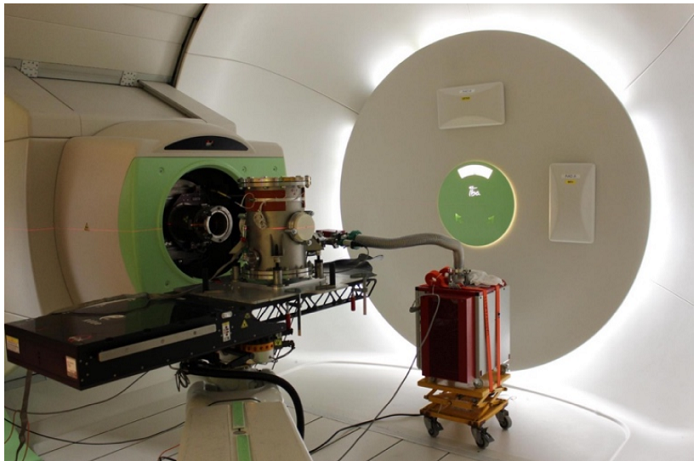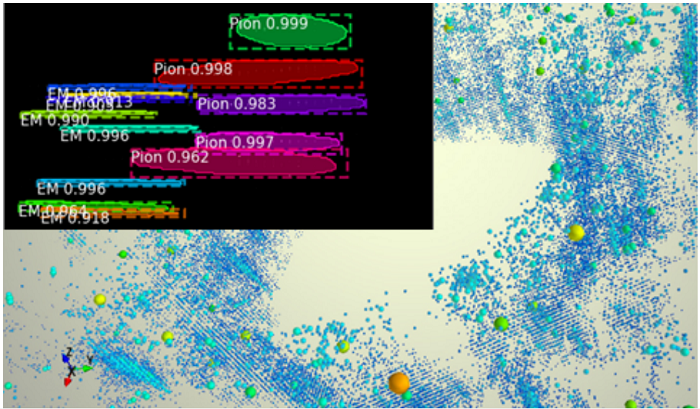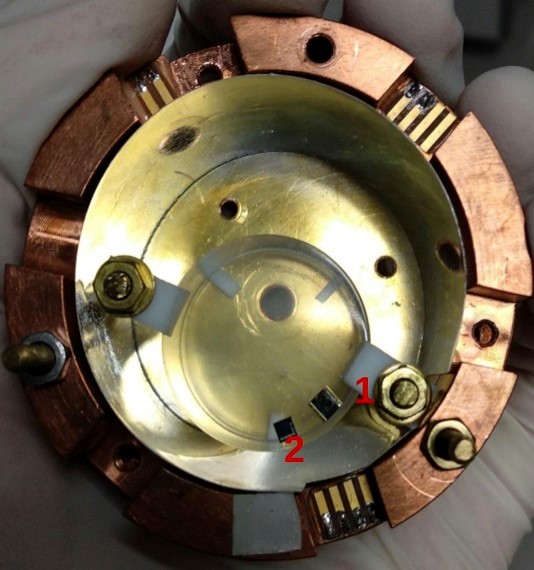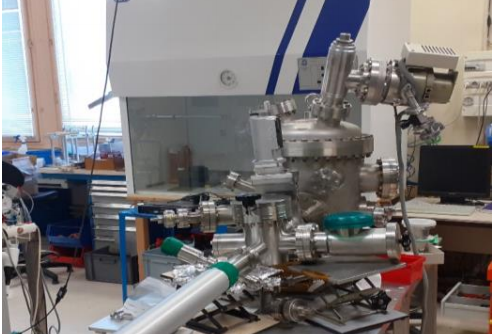P2IO regularly funds projects other than large projects of the emblematic or flagship type. 5 R&D projects have been funded in 2017: PEPITES, ACP, BASKET, Cherenkov Lab and CATTISA projects.
PEPITES
M. Verderi (LLR)
Dose delivery in proton therapy requires accurate and continuous measurement of the beam properties: intensity, position and profile. As the beam passes through the materials constituting a monitor, it undergoes a dispersion that must be limited to a submillimetre lateral spread at the patient level to be tolerable. For monitors located a few meters upstream of the patient, this constraint induces a material budget of less than 15 µm Water Equivalent Thickness (WET). In addition, the continuous presence of the monitor in the beamline implies a good radiation resistance. If the intensities of the beams used in the medical field are relatively low (a few nA), the prolonged exposure time induces integrated doses of the order of 106 to 108 Gy per year.
The PEPITES project is developing a fully functional prototype of an ultra-thin (10 µm WET) monitor for charged particle beams, responding to these constraints and capable of operating permanently on accelerators at intermediate energies (O(100 MeV)). The monitor exploits the phenomenon of secondary electron emission for the signal. Gold tracks of 50 nm thickness are deposited on an ultra-thin polyimide substrate. When the beam crosses the tracks, the secondary electron signal is generated, and is read for each track independently, allowing the measurement of the lateral profile of the beam.
The PEPITES R&D 2017 grant from the P2IO LabEx was used to explore two areas of research: radiation resistance of the materials envisaged for the construction of the prototype and the measurement of the secondary electron emission signal at therapeutic energies (100-230 MeV).
Radiation resistance studies of the materials were carried out at the Arronax cyclotron (Accelerator for Research in Radiochemistry and Oncology in Nantes Atlantique, GIP). Kapton samples of 8 µm thickness were irradiated with several choices of fluence of 68 MeV proton beams. Subsequent analyses (visible UV and IR spectrometry, SEM) showed that although damaged, the polyimide substrates exhibit radiation resistant properties capable of meeting the exposure requirements envisaged for our detector. These results were presented at the ECAART conference and published in the following publications (Nuclear Inst. and Methods in Physics Research, B (2020) Vol. 466, pp. 8-11, https://doi.org/10.1016/j.nimb.2020.01.003).
We also carried out a data collection campaign to study the secondary electron emission signal at the CPO (Orsay Proton Therapy Center, Institut Curie). The detector, immersed in a chamber connected to a pump ensuring a vacuum of 10-4 mbar, was irradiated with proton beams of energies varying between 100 and 230 MeV, with an intensity of 2 or 3 nA. The signal was measured both in forward (electrons emitted in the direction of proton propagation) and backward (emitted in the opposite direction) modes by rotating the isocentric arm around our chamber located on the patient's bed. Additional measurements at lower energies (17-70 MeV) are still in progress at the Arronax cyclotron and a reference article combining these results will be published..

Accelerated Computing for Physics (ACP)
G. Grasseau (LLR)
Objectives:
Promote the High Performance Computing (HPC) projects of our community by exploiting parallelism and/or accelerator-based computing, taking into account in particular :
Realisations:
The members of the ACP project quickly moved towards GPU and FPGA accelerator board technology with processors of different architectures as host nodes (AMD/Intel)..

A - R&D project environment/operation
Considering the great variability of the execution contexts of ACP application projects, the containerization (essentially through singularity) of systems and environments has been indispensable, such as :
On the application exploitation side, a resource reservation system has been put in place, focusing on performance testing and light production. In the same way, a GPU deployment manager for our Deep Learning applications, particularly adapted for Bayesian optimization, has been implemented to simultaneously exploit all the allocated computing resources (GPUs and CPUs).
B - Application R&D projects
The partners' simulation and analysis projects are very diversified. They range from adapting the implementation to architectures with an optimization phase to full development on the 2 ACP platforms.
List of the main projects :

Bolometers At Sub-KeV Thresholds (BASKET)
M. Vivier (Irfu/SPP)
Presentation of the project:
The BASKET project (Bolometers At Sub-KeV Thresholds) aims to explore the technology of scintillating bolometers to apply them to the detection of the coherent scattering process of neutrinos on nuclei (DCNN). DCNN is a new process for detecting low energy neutrinos (≤ 50 MeV) with an effective cross-section up to 1000 times larger than those of conventional detection channels [1], allowing to foresee a possible miniaturization of neutrino detectors in the future. This process is also sensitive to a wide spectrum of new physics: search for light sterile neutrinos, measurements of the electromagnetic properties of the neutrino, fine testing of the standard electro-weak model at low energies, etc.
Since its first observation in 2017 by the COHERENT collaboration, experimental programs to precisely measure this process in nuclear reactors have intensified. The experimental challenges are multiple because it is necessary to be able to measure the very small nuclear setbacks (typically below keV, or even 100 eV) induced by the coherent diffusion of reactor antineutrinos [2]. On the other hand, the background noise conditions offered by an experimental site close to a reactor are generally very unfavorable, and thus require fast detectors capable of discriminating the latter down to the lowest energies.
The BASKET project thus pursues two lines of research: the design of new crystals allowing an active rejection of background noise via a double heat/scintillation reading, and the testing of high-performance thermal sensors to improve the speed and energy threshold of the detectors.
Actions carried out and results:
The first action of the project turned towards the study of new crystals in lithium tungstate LWO. The choice of this material is not insignificant, as it contains both a heavy element (tungsten) very favorable for the detection of DCNN, and an element allowing the identification of neutron background noises, namely 6Li via the n + 6Li reaction → α + 3H. The tests of a first crystal of about 8 grams, coupled with a thermal sensor and a light detector were very conclusive, showing good bolometric and scintillation properties, and with a very good discrimination of background noises α/β(α) [3].
Building on this success, the project team has entered into a partnership with the Science and Engineering of Materials and Processes (SIMAP) laboratory in Grenoble for the growth of LWO crystals. The objective is to develop and perpetuate a production chain in France, with a view to possible enrichment with 6Li. The first LWO crystal was obtained at SIMAP, with an approximate mass of 130 g (approximate dimensions Ø=3.5 cm, H=3 cm), and should be tested before the end of 2020.

Finally, the team is conducting a parallel comparative study on different types of thermal sensors for reading the heat signal. The studies focus on three types of sensors: Ge-NTD (Germanium-Neutron Transmutation Doped) and Si-doped (Phosphorus and Boron) thermistors as well as MMCs (Magnetic Metallic Calorimeter). For each of these sensors, the performances in terms of threshold, response time and background noise discrimination are evaluated [4]. A study will also be carried out on the optimization of the size and geometry of the crystals in order to obtain a first prototype meeting the objectives set.
[1] D. Freedman, PRD 9, 1389-1392 (1974)
[2] G. Angloher et al., EPJ C 79, 1018 (2019)
[3] A. Aliane et al., NIMA 949, 162784 (2020)
[4] B. Mauri et al., NEUTRINO 2020, https://nusoft.fnal.gov/nova/nu2020postersession/pdf/posterPDF-386.pdf
Cherenkov Lab
V. Puill (LAL)
Context:
In High Energy Physics (HEP), particle identification can be performed using the time-of-flight technique: this procedure requires a simultaneous measurement of the moment of the particle and its velocity via time measurement. This method is particularly suitable for particle identification (e.g. pion/kaon separation) from a few hundred MeV to a few GeV. The measurement can be done with Cherenkov detection chains: by moving in a medium, a charged particle perturbs the electronic layers of each atom encountered, producing light which is then detected by photo-detectors. The main advantage of Cherenkov light (compared to scintillating light) is that it is emitted instantaneously along the trajectory of the particle in the material.
Another application of the Cherenkov detector in the field of PHE is the detection and measurement of the velocity of a deflected/extracted particle beam.
Project:
In the Cherenkov Lab project, studies and developments have been carried out to produce a detection chain capable of counting from a single particle to several hundred particles with an accuracy of 5% to 15% and a time resolution of 30 to 50 ps (depending on the number of incident particles). The device is designed to work in a hostile radiative environment (1012 n.cm-2) and, in the case of particle beam characterization, to be compatible with ultra-high vacuum (1012 mbar).
As the main sources of inaccuracies of this detector are the generation and collection of light in the radiator and the transit time of the photo-detector, studies have been carried out to optimize the light output (properties of the radiator and geometries, coupling to the photo-detector), mechanical integration via a metal flange and measurement of the time resolution of different photo-detectors has been performed (SiPM-PMT).
The choice of the nature of the radiator that produces the Cherenkov light and of these geometries is crucial. Dozens of simulations based on GEANT4 have been made to optimize the geometry of the detector, three of which have been tested at CERN with pion beams (Figure 1).

The mechanical integration of the radiator and the flange with the beam pipe (under vacuum in the case of beam control) is a technical challenge (figure 2). A special process has been developed, in collaboration with a company, for the brazing of quartz rods with vacuum flanges. As the resulting decrease in light yield is of the same order of magnitude as that measured when the light produced inside the quartz passes through the glass in contact with the photodetector, this method was not chosen for the final detection chain.

SiPM (1 nm2 and 9 mm2) of HAMAMAMATSU, KETEK and AdvansiD and MPC-PMT of HAMAMAMATSU, BURLE and PHOTEK were tested; the best temporal resolution of a single photoelectron was measured with the MCP-PMT of PHOTEK (MAPMT228) and BURLE (XP85012) with 45 and 55 ps respectively.
A complete string (Figure 3) placed inside the beam tube of the SPS gas pedal at CERN allows counting from 1 to 309 incident protons.

CATTISA
D. Longuevergne (IPNO)
The complete characterisation of innovative thermal and surface treatments to improve the performance and reliability of superconducting accelerator structures and beam chambers requires significant surface analysis resources. Indeed, it is important to note that many phenomena limiting the performance of accelerators are directly linked to the interactions between particles (electrons, ions, photons) and the surface of the material constituting the walls of vacuum chambers or radio frequency superconducting cavities, for example.
The nature of the material as well as the surface morphology and chemistry can directly impact the overall behaviour of components in an accelerator. The crucial surface parameter to limit these effects is the secondary electronic emission coefficient (SEY). The CATTISA project financed the improvement of the IJCLab's SEY test frame with, in particular, the purchase of a heated sample holder and a vacuum sample introduction system.

The secondary electron production efficiency on copper constituting the LHC beam screen was carried out in this test frame in order to identify the role played by the surface chemistry of copper on the electron emission efficiency. The fundamental role of chemical compounds on the surface (contaminants, presence of amorphous carbon and native oxides) on the secondary electron production efficiency was demonstrated.
Numerous activities have also been carried out on Atomic Layer Deposition (ALD) and doping of bulk Niobium such as:
In conclusion, the P2IO CATTISA funding has enabled the improvement of the means of analysis and surface treatment (oven, bench, ALD, etc.) shared by IJCLab and IRFU, which are essential for activities on alternative surface treatments for the improvement of future accelerator components.
